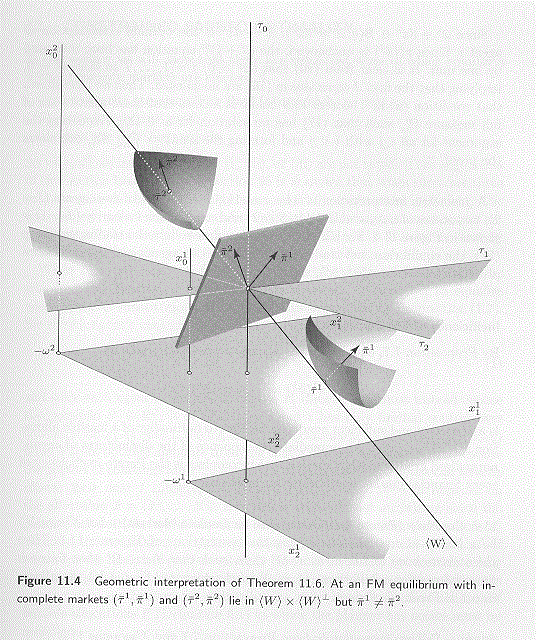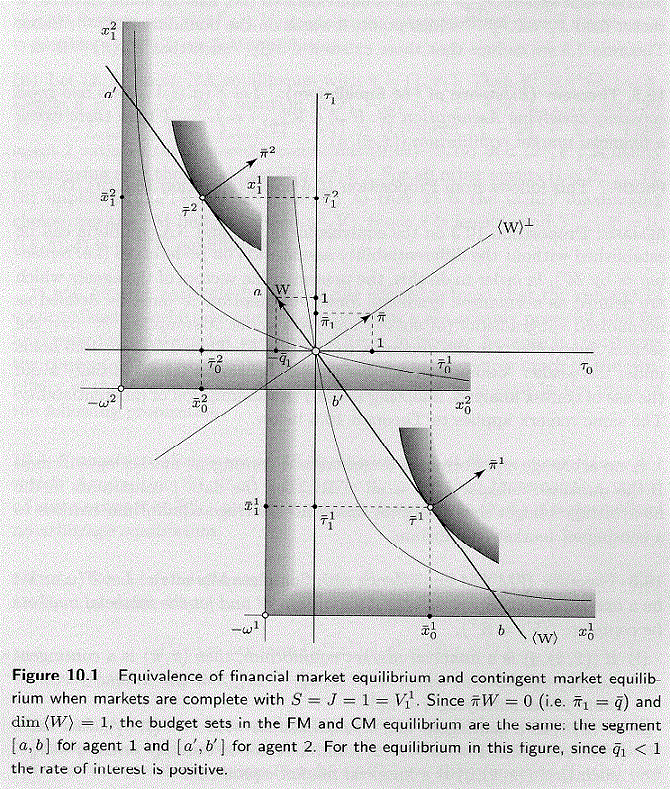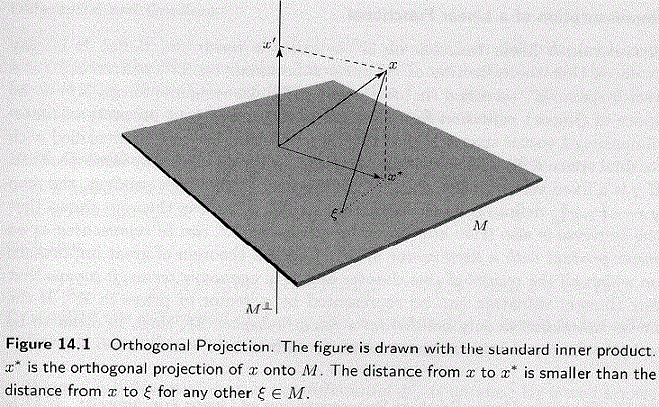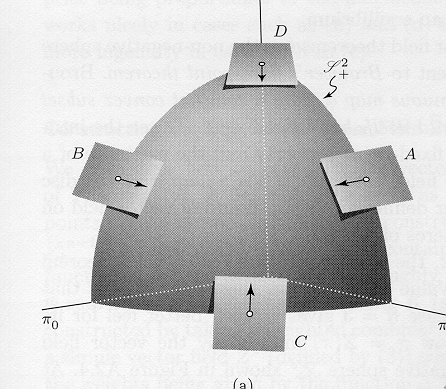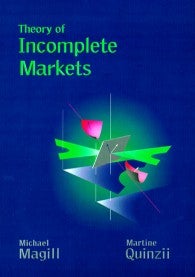 “This authoritative and comprehensive exposition of equilibrium theory for incomplete markets brings together in clear and systematic way twenty five years of research results in finance and economics throwing light on the role and limits of markets in coping with uncertainty about the future. The exposition is always clear and pedagogical; the book is a remarkable blend of rigourous elegance and economic wisdom. It will stand as a lasting reference manual and advanced textbook.” – Jacques DREZE, CORE, Belgium.
“This authoritative and comprehensive exposition of equilibrium theory for incomplete markets brings together in clear and systematic way twenty five years of research results in finance and economics throwing light on the role and limits of markets in coping with uncertainty about the future. The exposition is always clear and pedagogical; the book is a remarkable blend of rigourous elegance and economic wisdom. It will stand as a lasting reference manual and advanced textbook.” – Jacques DREZE, CORE, Belgium.
“The study of incomplete markets developed gradually over the last twenty-five years and required both new ways of thinking and new techniques of analysis. The time is ripe for a survey, and Magill and Quinzii, both important contributors to the field, have shown their mastery here. Their exposition is the simplest consistent with careful study, and they have connected the current literature with its historic origins in exemplary fashion.” – Kenneth ARROW, Stanford University.
“Great progress has been made in the past twenty years in the analysis of general competitive equilibrium with incomplete financial markets. This text makes the important results of the literature accessible to non-specialists for the first time. The book deserves to be studied by all monetary and financial economists who care about the analytical foundations of their subjects.” – Michael WOODFORD, Princeton University.
“Theory of Incomplete Markets by Magill and Quinzii is certain to stimulate and excite future generations of students of economic theory as my generation was inspired by Debreu’s Theory of Value.” – Donald BROWN, Yale University.
“By redefining the concept of a commodity, one can immediately extend the General Equilibrium model to uncertainty (as well as to time, and to space). But for this, markets must be complete. In an impressive book, Michael Magill and Martine Quinzii do this extension in the framework of the new theory of incomplete markets that they powerfully contributed toward building. Their deep, original work, which aims at a wide audience of readers, contains a great wealth of knowledge for everyone of them.” – Gerard DEBREU, European University Institute, Florence.
“The frontier of research in General Equilibrium Theory today lies in the field of incomplete markets. The book by Magill and Quinzii gives an excellent account of this field by two of its principal cultivators. In addition it is a pleasure to read.” – Lionel McKENZIE, University of Rochester.
“Magill and Quinzii have carefully and cogently summarized a large body of recent research on general equilibrium models of incomplete security markets. In its treatment of everything from the basic mathematical tools to such applications as production and the role of money, Theory of Incomplete Markets is definitive, and is likely to remain so for a long time.” – J. Darrell DUFFIE, Stanford University.
“This is an ambitious book—as, indeed, is any serious effort to work through the ramifications of incomplete contracting. Professors Magill and Quinzii bring the rudiments of institutional economics (bounded rationality, opportunism, asset dependence, organization form) into general equilibrium theory in ways that have hitherto defied analysis. This is an important book.” – Oliver E. Williamson, University of California.
From the foreward by Werner Hildenbrand
When I was asked to write a foreword for Theory of Incomplete Markets, I felt very honored since at that time I had already read various versions of the manuscript, and it was clear to me that the final product would become a splendid book (a rational expectation). Yet why did Martine and Michael ask me, having made no scientific contribution to the field? Surely, they knew that I am an ardent admirer and respectful supporter of General Equilibrium Theory. Also they must have felt my active and lasting interest in their research during the last ten years. Indeed, during every BOWO from 1988 to 1992 the “theory of incomplete markets” was always a central theme of the Bonn Workshop. I immensely enjoyed following closely the impressive annual progress in this research area and the exchange of ideas, opinions and often heated arguments.
When I read Debreu’s Theory of Value thirty years ago, I was enthusiastic about General Equilibrium Theory until I came to chapter 7: Uncertainty. The treatment of time and uncertainty was not entirely convincing at least from a descriptive point of view. Time and uncertainty was treated in an amazingly simple way. This simplicity was achieved by postulating a highly idealized market structure, the Arrow Debreu complete system of contingent contracts. But invoking this hypothesis dispenses with the modelling of expectations of what the future has in store and gone are the joys of life.
Theory of Incomplete Markets (the present book and the forthcoming volume 2) is an essential extension of Debreu’s chapter 7; it offers a more realistic and richer modelling of time and uncertainty. This important new development has its origin in the well known fundamental contributions by K. Arrow (1953) and R. Radner (1972). In Radner’s treatment of time and uncertainty, economic agents trade sequentially on spot markets and are unable to make more than limited contractual commitments into the future to coordinate their activities and share their risks.
During the academic year 1985/86, G. Debreu organized a one year workshop on Mathematical Economics at the Mathematical Sciences Research Institute at Berkeley. I remember when at one of the weekly seminars D. Duffie and W. Shafer presented their paper, “Equilibrium in incomplete markets A basic model of generic existence”. In essence, they showed how a difficulty in Radner’s model, pointed out by 0. Hart (1975) by some well chosen examples, could be resolved. Due to this development there was enthusiasm again among a small group of mathematical economists. General Equilibrium Theory with Incomplete Maxkets became an active field of research. Martine and Michael, among others, have made outstanding contributions to this new and important development.
The present book is the first part of the contemporary story of Incomplete Markets. This is a splendid book. It contains the most recent research and still is eminently readable by any economist who is willing to invest some effort. Even though Martine and Michael do not sidestep the unescapable technical problems, the message of the book can still be understood and appreciated by readers who do not place great value on the technical skills of mathematical economists. The sections entitled Motivation and Summary and Historical Remarks are masterpieces. They give deep insight into the subject and suggest new directions for research.
No economist should miss the chance to read Theory of Incomplete Markets.
Bonn, February 1995
Review by Thorsten HENS
Theory of Incomplete Markets outlines how the important field of finance. including such celebrated results as the CAPM, the martingale asset pricing theory, and the Modigliani Miller theorem, can be incorporated into the standard general equilibrium framework. This remarkable achievement was made possible by modifying the complete contracts market structure of the general equilibrium model towards a more realistic market structure of reopening spot markets across which income can be transferred using an incomplete system of financial markets. Furthermore, the authors analyze how this modification of the market structure changes the fundamental predictions of general equilibrium theory: existence and efficiency of competitive equilibria. Finally, the book offers new insights into the important macroeconomic question of the optimality of monetary policy.
Theory of Incomplete Markets has been written by two outstanding contributors . to the new and important developments of the general equilibriurn model with incomplete markets. The book is written for economists with some background in economic theory and mathematics and it serves as well as a graduate textbook.
The main part of the book is divided into seven chapters. The first chapter is a very general and enthusiastic introduction to the field of incomplete markets. Magill and Quinzii put their introduction under the motto attributed to Keynes 1937: “Perhaps the reader feels that this general. philosophical disquisition on the behavior of mankind is somewhat remote from the economic theory under discussion.” I suppose this indicates that they themselves had the impression that the introduction needs to be defended against the critique of being too general. or too philosophical. Even though I enjoyed the introduction very much, a less patient reader might become somewhat upset. Magill and Quinzii praise the theory of incomplete markets as being an outgrowth of bounded rationality and contract theory. This raises high expectations for the rest the book. However, one soon learns that agents are still very rational. Agents maximize utility over an arbitrary finite horizon while perfectly foreseeing all periods’ equilibrium prices! A more moderate position. Namely that the theory of incomplete markets is still very classical in nature and only departs from the standard general equilibrium model by modifying the market structure seems more appropriate. Chapter 2 presents the most fundamental case (of the incomplete markets model: the two period model. The contingent contracts model and the incomplete financial markets model are nicely related via the no arbitrage equilibrium concept. Hence, the incomplete markets model can indeed be seen as a standard general equilibrium model in which net transfers of agents are restricted to lie in the space of income transfers generated by the existing assets. This equivalence draws on the fundamental theorem of asset prices (Theorem 9.3) which demonstrates how the important notion of no arbitrage can be used and incorporated into the general equilbrium model. Based on this result, existence and generic inefficiency of equilibria as well as their constrained efficiency is rigorously proved. Chapter 3 further exploits this theorem in order to derive formulas for two period security pricing incorporating the CAPM as a special case. Chapter 4 generalizes the results of chap. 2 to stochastic finance economies. New aspects are that existence of equilibria can no longer be demonstrated for all characteristics of the economy and that even constrained Pareto efficiency no longer holds. In chap. 5 it is demonstrated how in the stochastic model, based on the results of chap. 3. the important martingale pricing theory can be developed. Moreover this theory is identified with the efficient market hypothesis. Chapter 6 incorporates production into the two period model. It is well known that this is not straightforward since when markets are incomplete, shareholders have conflicting interests which are not easily aggregated into an objective function of the firm. Moreover, in this chapter the Modigliani Miller theorem is presented and thoroughly discussed. Finally, chap. 7 introduces money into the two period exchange economy via some “cash in advance” constraints. Magill and Quinzii demonstrate that, as claimed by monetarist macroeconomists, a monetary policy introducing additional uncertainty into the economy is not desirable.
Besides this very rigorously done main part which is written in the standard way of setting up a model, giving assumptions, stating theorems, and giving proofs the book has some attractive additional features.
One of these features are the extensive verbal and intuitive discussions of the general theory, found in the general introduction of chap. 1, in the four to five pages which proceed every chapter as well as in the historical remarks at the end of every chapter. Altogether they add up to approximately 23 percent of the text. I found these parts very enjoyable.
The field of incomplete markets suffers from the problem that it is hard to penetrate without a profound mathematical background. Perhaps for this reason Magill and Quinzii decided to dedicate part of their book purely to mathematics. Indeed. again counting pages reveals that on average more than twenty percent of the text is on pure mathematics. reaching as high as forty percent in chaps. 2 and 3. This is a nice but perhaps overly thorough service to the average reader.
A splendid part of the book are the many beautiful figures offering nice geometric interpretations of the abstract results, the most beautiful of which the one illustrating Pareto efficiency became part of the cover.
Every chapter finishes with exercises. Only a third of the exercises are specific examples illustrating how the general forces of the theorems work in special cases. Most exercises are blueprints to develop new and advanced pieces of theory. It would have been useful if the authors had indicated their level of difficulty.
Finally, the book has an extensive list of more than 400 references ranging from the years 533 to 1995. It would have been helpful if the authors had given some hint as to which of these they especially recommend for further reading.
Having outlined what the Theorv of hicomplete Markets covers. it is fair in passing to mention as well what it does not cover.
The perhaps most restrictive limitation is that the book focuses on the simple case of a single consumption good being available in every spot market. Magill and Quinzii justify this restriction by referring to I. Fisher who proceeded similarly in his The Theory of Interest some sixty years ago. This should be seen as a first step towards the general theory which will soon be covered by the second volume of their book. However, the results of the multiple period model given in chaps. 4 and 5 already resemble the case of the two period multiple commodities model. Technically. the same difficulties arise. As such. it is an open question whether the multiple commodity case could not have been incorporated at only a small extra cost.
The authors appear no less selective in the topics which they dealt with. They are mainly concerned with existence and optimality of equilibria. In this last respect the book remains incomplete since it does not mention any second welfare theorem for the incomplete markets model. Magill and Quinzii have chosen to omit the interesting aspect of self fulfilling prophecies nicknamed sunspot equilibria. An even more serious restriction, especially for financial economics. is not to consider asymmetric information. The same is true for recent research on the uniqueness, the stability, and comparative statics in incomplete markets. Finally, computational general equilibrium models with incomplete markets are omitted. Given the framework of the book the authors could not have dealt with all these topics as well. But a section in which these hot topics were mentioned would have been extremely useful. especially for graduate students.
To summarize, Theory of Incomplete Markets is a very thorough book which contains an excellent introduction into some recent research in the active area of incomplete markets. Even though some survey articles are available on incomplete markets this is the only available textbook on this topic. It offers the most thoroughly worked out introduction to date in providing the reader with a nice guide to the history of financial economic theory and also to the mathematics of incomplete markets.
In the book’s foreword, Werner Hildenbrand concludes his appraisal by saying that “No economist should miss the chance to read Theory of Incomplete Markets.” This is certain-ly true. But be aware that Theory of Incomplete Markets is itself incomplete, and having read the first volume one will look forward to the second one!
Bielefeld, Germany
